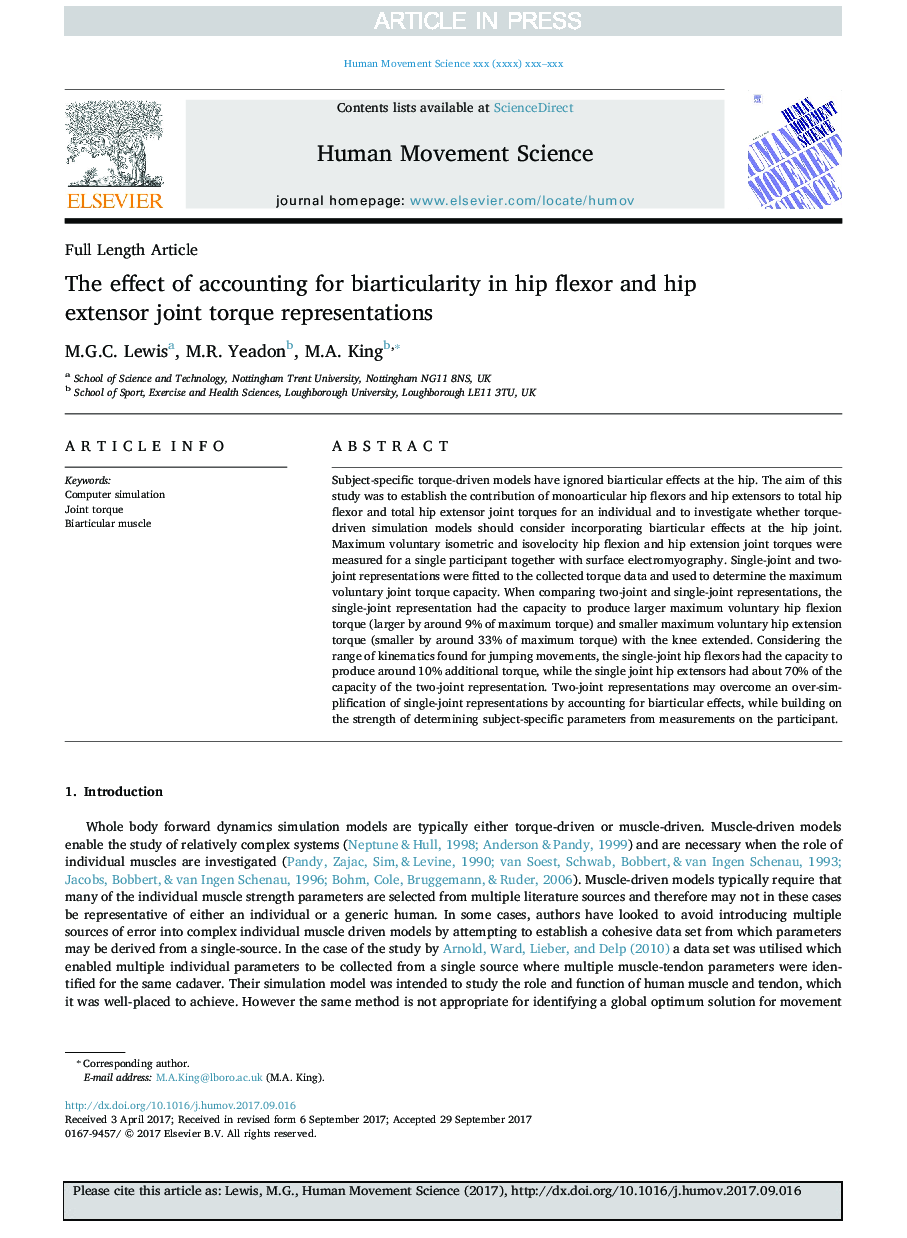| کد مقاله | کد نشریه | سال انتشار | مقاله انگلیسی | نسخه تمام متن |
|---|---|---|---|---|
| 7291069 | 1474207 | 2018 | 12 صفحه PDF | دانلود رایگان |
عنوان انگلیسی مقاله ISI
The effect of accounting for biarticularity in hip flexor and hip extensor joint torque representations
ترجمه فارسی عنوان
اثر حسابداری برای بیارتیکالوری در بازتاب گشتاور مفاصل انعطاف پذیر فک و مفصلی هیپ
دانلود مقاله + سفارش ترجمه
دانلود مقاله ISI انگلیسی
رایگان برای ایرانیان
کلمات کلیدی
شبیه سازی رایانهای، گشتاور مشترک، عضله بیارتیچول
ترجمه چکیده
مدل های گشتاور خاص با موضوع، اثرات بیارتیوکولار را در ران ها نادیده می گیرند. هدف از این مطالعه تعیین سهم فلکسورهای مفصلی خلفی و مفصل دهان و دندان هیپنوتیزم در محدوده مفصل انعقاد مفصلی فلکسور و کلسترول مفصلی برای یک فرد و بررسی اینکه آیا مدلهای شبیه سازی گشتاور محور در نظر گرفتن ترکیبات بیارتیوکولار در مفصل مفصلی باید باشد. حداکثر تعداد داوطلبانه ایزومتریک و ایزوالوسیته فلکشن خلط و گشتاور مفصل گسترش مفصل ران برای یک شرکت کننده تنها با الکترومیوگرافی سطحی اندازه گیری شد. نمایندگی های تک تک و دو طرفه به داده های گشتاور جمع آوری شده و برای تعیین حداکثر ظرفیت گشتاور مشترک داوطلبانه استفاده می شود. در مقایسه با بازسازی دو مفصل و تک تک، نمایندگی تک تک توانایی تولید حداکثر حداکثر گشتاور فلکس دائم خم وجود داشت (بزرگتر از 9 درصد از حداکثر گشتاور) و حداکثر گشتاور حداکثر حداکثر داوطلب جراح (که در حدود 33 درصد کوچکتر بود) از حداکثر گشتاور) با زانو گسترش یافته است. با توجه به محدوده سینماتیک موجود در حرکات پرش، فلاکسرهای مفصل مفصل تک تک توانایی تولید حدود 10 درصد گشتاور اضافی را داشتند، در حالی که انعکاس دهنده های مفصل مفصل مفصلی حدود 70 درصد از ظرفیت نمایندگی دو طرفه را داشتند. نمایندگی های دو جانبه ممکن است بیش از حد ساده سازی بازنمودهای تک تک با حسابداری برای اثرات بیارتیچولا غلبه کنند، در حالی که بر اساس استحکام تعیین پارامترهای خاصی از موضوع از اندازه گیری در شرکت کننده.
موضوعات مرتبط
علوم زیستی و بیوفناوری
علم عصب شناسی
علوم اعصاب شناختی
چکیده انگلیسی
Subject-specific torque-driven models have ignored biarticular effects at the hip. The aim of this study was to establish the contribution of monoarticular hip flexors and hip extensors to total hip flexor and total hip extensor joint torques for an individual and to investigate whether torque-driven simulation models should consider incorporating biarticular effects at the hip joint. Maximum voluntary isometric and isovelocity hip flexion and hip extension joint torques were measured for a single participant together with surface electromyography. Single-joint and two-joint representations were fitted to the collected torque data and used to determine the maximum voluntary joint torque capacity. When comparing two-joint and single-joint representations, the single-joint representation had the capacity to produce larger maximum voluntary hip flexion torque (larger by around 9% of maximum torque) and smaller maximum voluntary hip extension torque (smaller by around 33% of maximum torque) with the knee extended. Considering the range of kinematics found for jumping movements, the single-joint hip flexors had the capacity to produce around 10% additional torque, while the single joint hip extensors had about 70% of the capacity of the two-joint representation. Two-joint representations may overcome an over-simplification of single-joint representations by accounting for biarticular effects, while building on the strength of determining subject-specific parameters from measurements on the participant.
ناشر
Database: Elsevier - ScienceDirect (ساینس دایرکت)
Journal: Human Movement Science - Volume 57, February 2018, Pages 388-399
Journal: Human Movement Science - Volume 57, February 2018, Pages 388-399
نویسندگان
M.G.C. Lewis, M.R. Yeadon, M.A. King,
